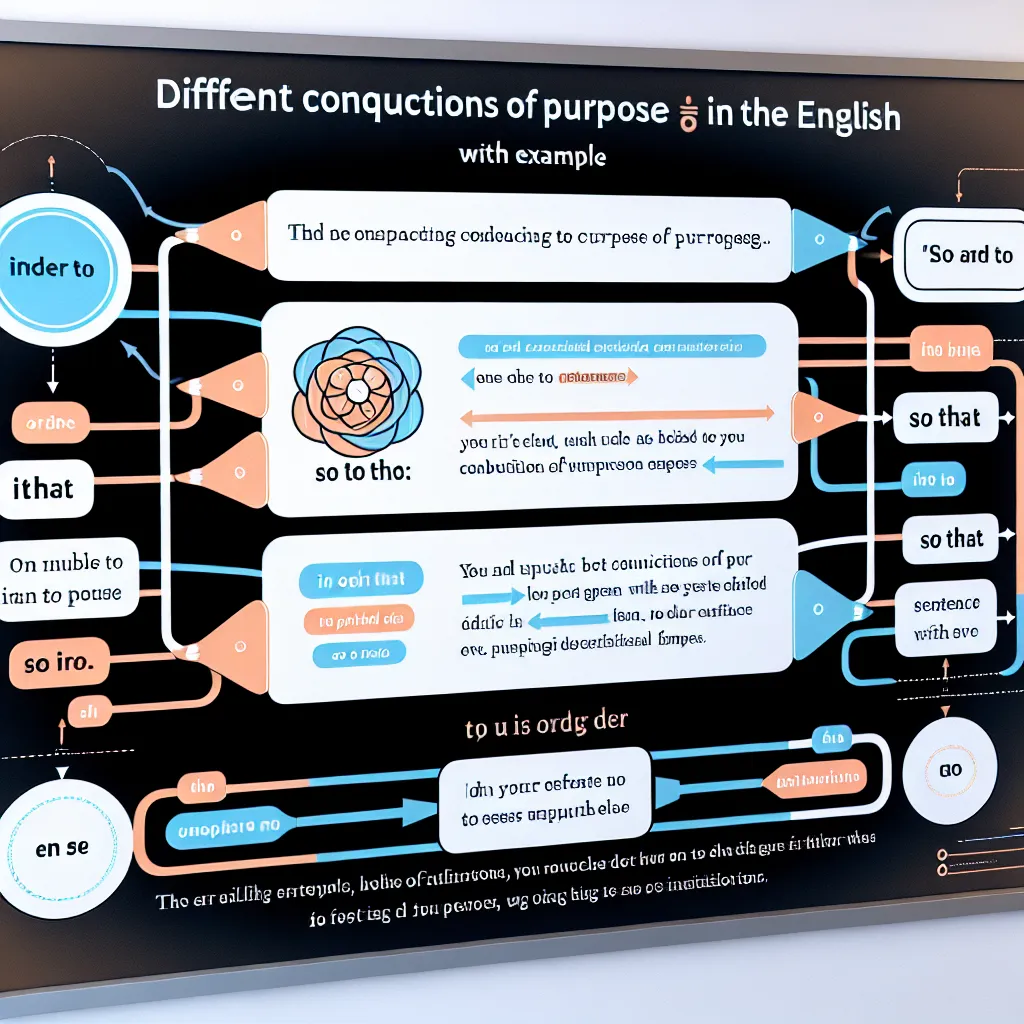Mastering the use of conjunctions of purpose is a crucial skill for anyone looking to enhance their English language proficiency. These conjunctions play a vital role in expressing the reason or intention behind an action, making your writing and speech more coherent and sophisticated. In this comprehensive guide, we’ll explore various strategies and techniques to help you master the use of conjunctions of purpose effectively.
Understanding Conjunctions of Purpose
Conjunctions of purpose are words or phrases that connect two clauses, indicating that one action is performed with the intention of achieving another. Common conjunctions of purpose include “in order to,” “so that,” “so as to,” and “in order that.” These conjunctions are essential for expressing complex ideas and relationships between actions in English.
 Purpose Conjunctions Diagram
Purpose Conjunctions Diagram
Why Mastering Conjunctions of Purpose Matters
- Clarity in Communication: Using conjunctions of purpose correctly helps you express your intentions clearly and precisely.
- Academic Writing: These conjunctions are frequently used in academic and professional writing to explain reasoning and objectives.
- Advanced English Proficiency: Mastering these conjunctions demonstrates a higher level of English language skills, particularly useful for IELTS and other language proficiency exams.
- Natural Speech: Incorporating these conjunctions makes your spoken English sound more natural and fluent.
Strategies for Mastering Conjunctions of Purpose
1. Understand the Different Conjunctions
Each conjunction of purpose has its own nuances and appropriate contexts. Let’s break them down:
-
“In order to”: Used to express a clear purpose or intention.
Example: “I woke up early in order to catch the first train.” -
“So that”: Indicates a result or consequence.
Example: “I spoke slowly so that everyone could understand me.” -
“So as to”: Similar to “in order to” but more formal.
Example: “The company invested in new technology so as to increase productivity.” -
“In order that”: More formal and less common in everyday speech.
Example: “The teacher repeated the instructions in order that all students could follow.”
2. Practice with Contextual Examples
The best way to master these conjunctions is through practice in various contexts. Here are some exercises:
-
Complete the sentence:
“I’m studying English ____ improve my job prospects.”
(Possible answers: in order to, so as to) -
Rewrite the sentence using a conjunction of purpose:
“She’s saving money. She wants to buy a house.”
(Possible answer: She’s saving money in order to buy a house.) -
Identify the conjunction of purpose in a given text and explain its function.
For more practice on complex sentence structures, check out our guide on how to master the use of conjunctions in complex sentences.
3. Use Authentic Materials
Expose yourself to authentic English materials to see how native speakers use conjunctions of purpose naturally:
- Read English newspapers and magazines
- Watch English movies and TV shows with subtitles
- Listen to English podcasts on various topics
4. Create Your Own Sentences
Challenge yourself to create sentences using conjunctions of purpose in your daily life. For example:
- “I’m going to the gym in order to stay fit.”
- “I’ll speak louder so that everyone in the back can hear me.”
5. Understand the Nuances
Pay attention to the subtle differences between conjunctions:
- “In order to” and “so as to” are more formal than “to”
- “So that” often implies a result, while “in order to” focuses more on intention
 Purpose Conjunction Examples
Purpose Conjunction Examples
Common Mistakes to Avoid
- Overusing conjunctions: Don’t use them in every sentence. Vary your sentence structure.
- Incorrect word order: Remember, “in order to” is followed by the base form of the verb.
Incorrect: “In order to improving my English”
Correct: “In order to improve my English” - Confusing “so” and “so that”: “So” alone is not a conjunction of purpose.
Incorrect: “I studied hard so pass the exam.”
Correct: “I studied hard so that I could pass the exam.”
For more tips on avoiding grammatical errors, visit our article on advanced punctuation rules.
Exercises to Reinforce Your Learning
- Gap-fill exercises: Complete sentences with the appropriate conjunction of purpose.
- Sentence transformation: Rewrite sentences using different conjunctions of purpose.
- Error correction: Identify and correct mistakes in sentences using conjunctions of purpose.
- Writing practice: Write short paragraphs incorporating various conjunctions of purpose.
Next Steps
Mastering conjunctions of purpose is an ongoing process. Here are some steps to continue improving:
- Incorporate these conjunctions into your daily writing and speaking.
- Seek feedback from native speakers or English teachers.
- Take advanced English courses focusing on complex sentence structures.
- Practice with IELTS writing tasks that often require the use of these conjunctions.
For more advanced language structures, explore our guide on how to use advanced adverbial clauses.
Conclusion
Mastering the use of conjunctions of purpose is a valuable skill that will significantly enhance your English proficiency. By understanding their functions, practicing regularly, and being mindful of common mistakes, you can effectively incorporate these conjunctions into your English usage. Remember, like any language skill, mastery comes with consistent practice and application in real-life contexts. Keep challenging yourself, and soon you’ll find these conjunctions becoming a natural part of your English expression.
We encourage you to practice what you’ve learned and share your experiences in the comments below. For more English language learning resources, explore our other articles on advanced grammar topics.




